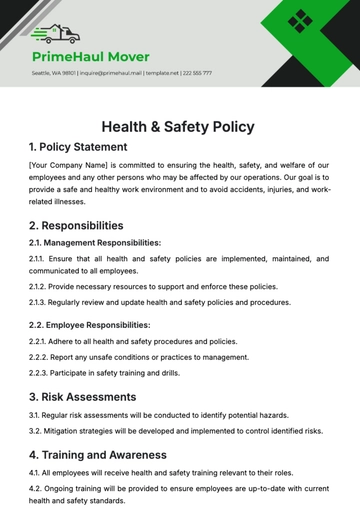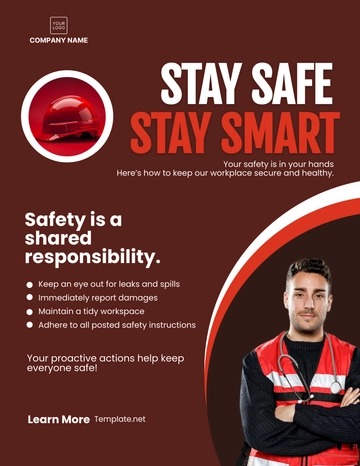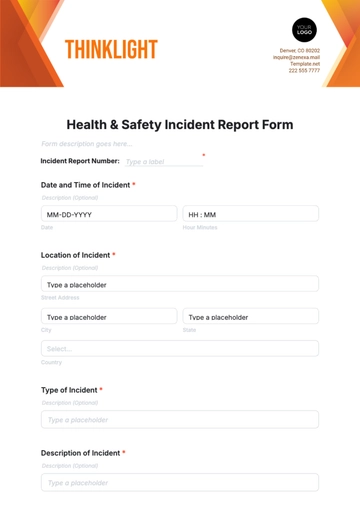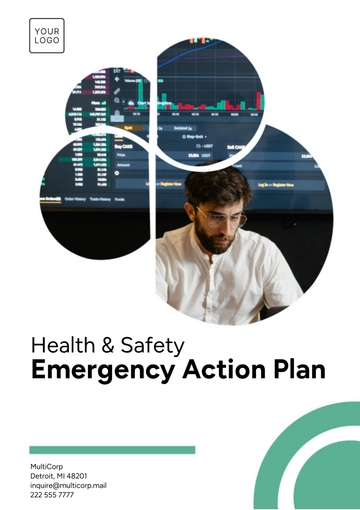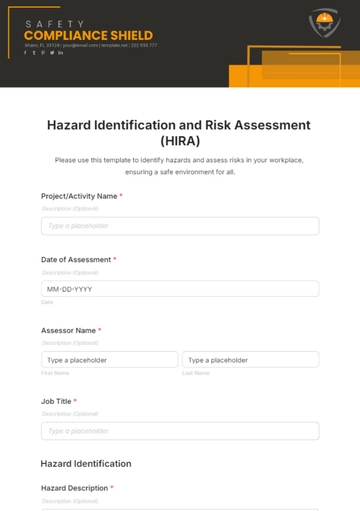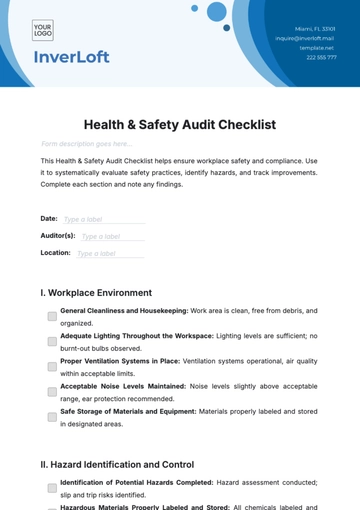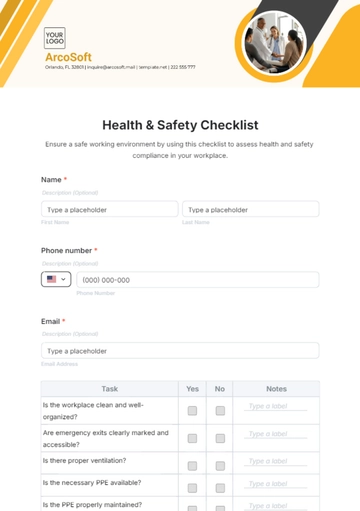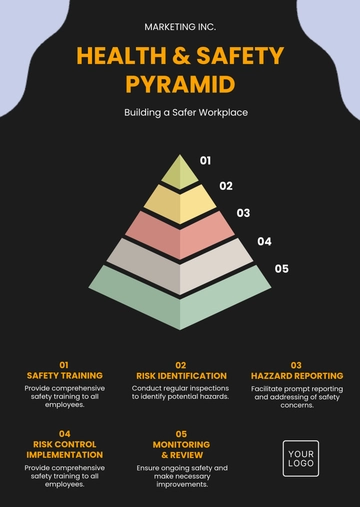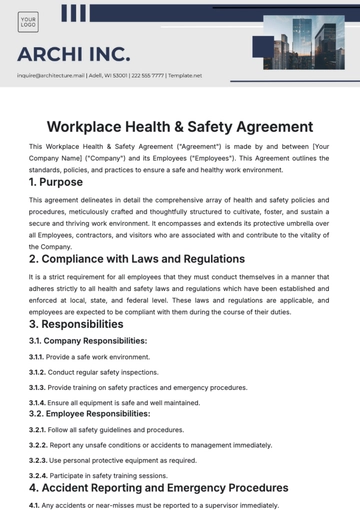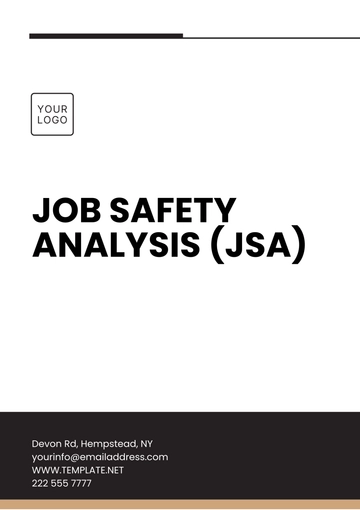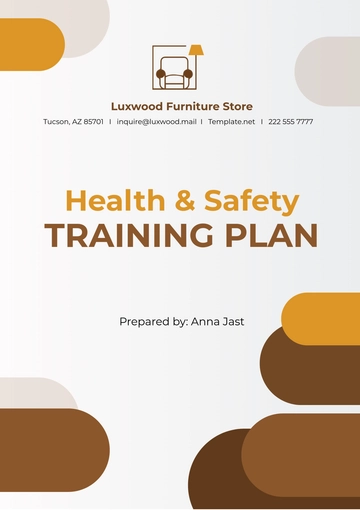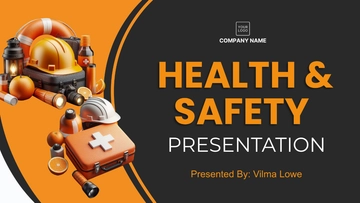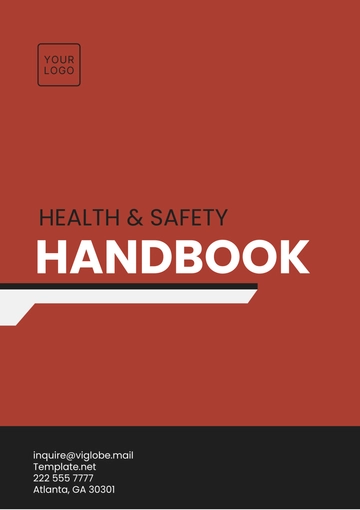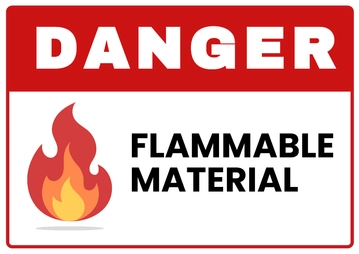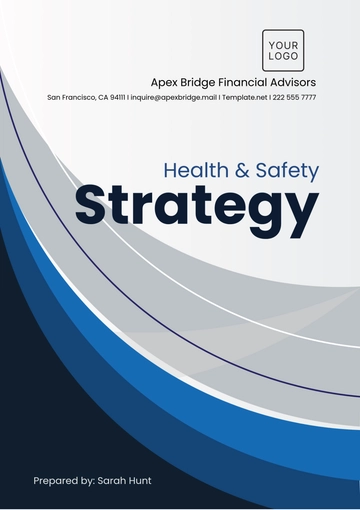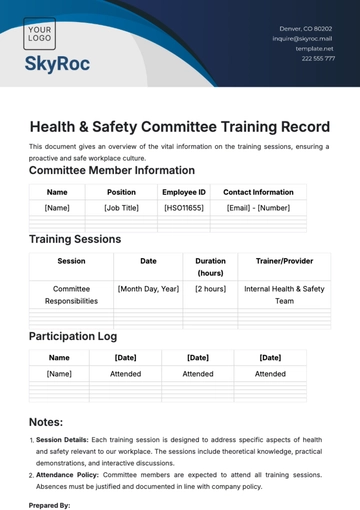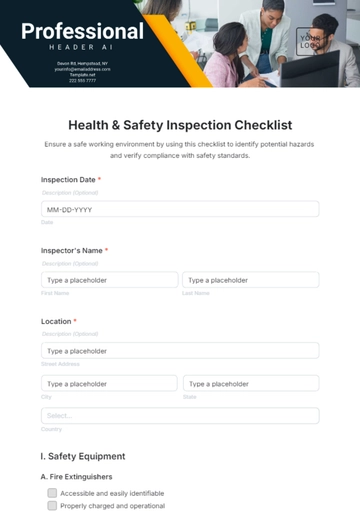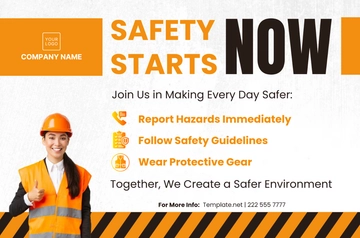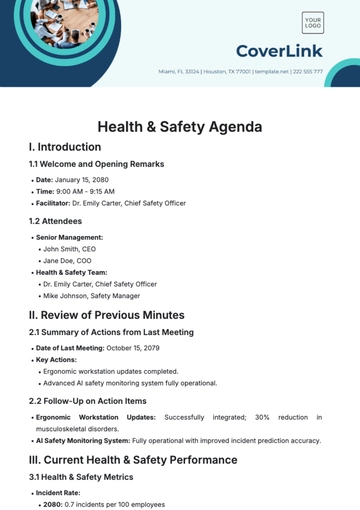Free Health & Safety Committee Documentation
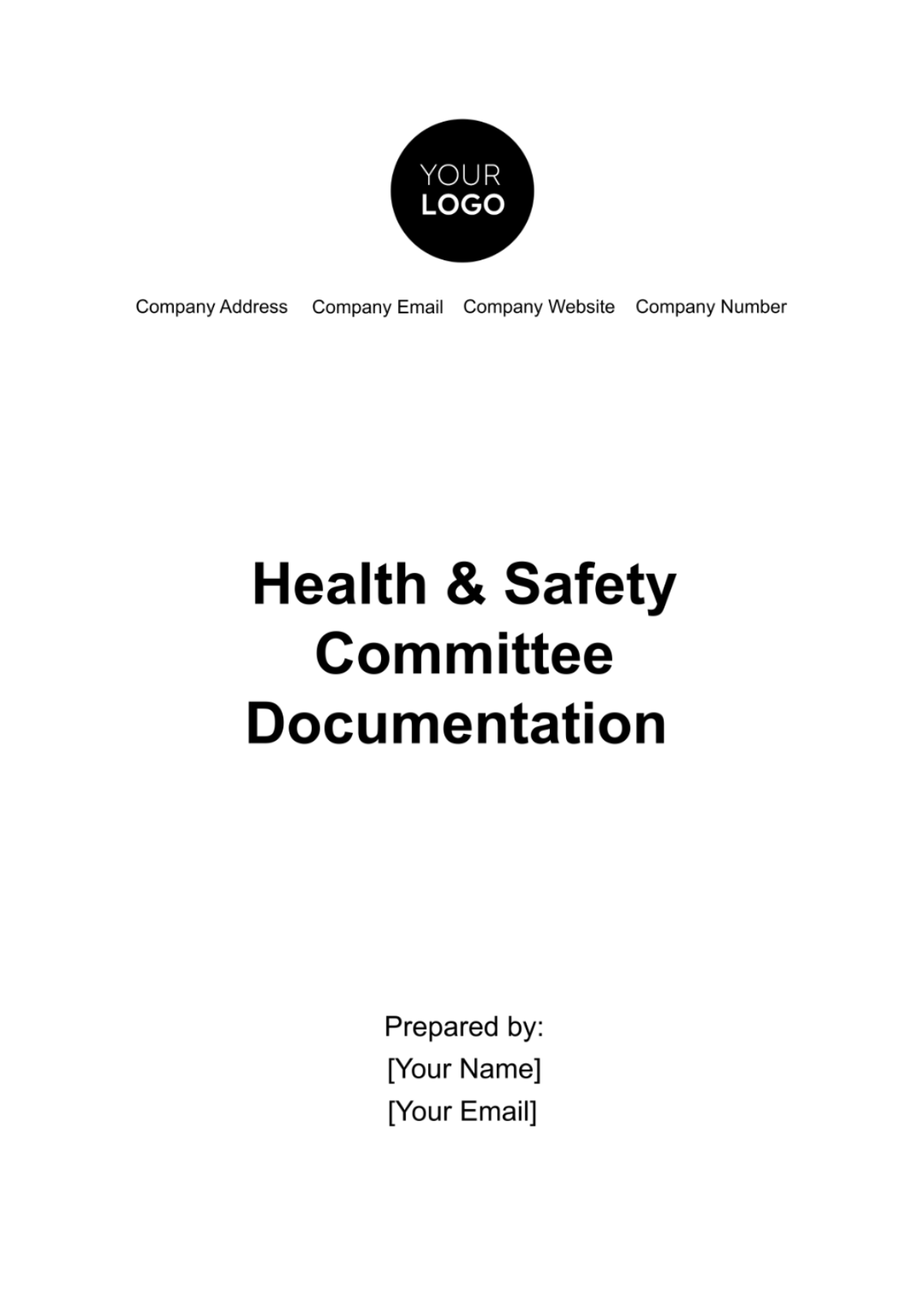
I. Introduction
A. Background
1. Overview of the Organization
[Your Company Name] is committed to providing a safe and healthy working environment for all employees, visitors, and stakeholders. This Health and Safety Committee Documentation outlines the framework, policies, and procedures established to achieve this commitment.
2. Purpose and Importance of the Health and Safety Committee
The Health and Safety Committee is instrumental in identifying, assessing, and managing risks within the workplace. By fostering a culture of safety, the committee aims to prevent accidents, protect employees, and ensure compliance with relevant regulations.
B. Objectives
1. Primary Goals of the Committee
a. Promote a proactive approach to health and safety.
b. Identify and mitigate workplace hazards.
c. Enhance emergency preparedness and response.
2. Desired Outcomes for Workplace Safety and Health
a. Reduction in workplace accidents and incidents.
b. Increased employee awareness and compliance with safety measures.
II. Committee Structure and Membership
A. Committee Charter
1. Mission and Scope
The Health and Safety Committee is dedicated to creating and maintaining a safe working environment through proactive measures, education, and continuous improvement. The scope encompasses all organizational departments and facilities.
2. Authority and Responsibilities
The committee is authorized to conduct risk assessments, investigate incidents, propose safety policies, and recommend corrective actions. Responsibilities include monitoring compliance, conducting regular inspections, and promoting safety awareness.
B. Membership
1. Chairperson: Leads meetings, ensures agenda adherence, and represents the committee.
2. Vice Chair: Assumes chairperson responsibilities in their absence.
3. Secretary: Records meeting minutes and maintains documentation.
4. Members: Actively participate in discussions, inspections, and incident investigations.
III. Meetings and Communication
A. Frequency and Scheduling
1. Regular Meeting Schedule
The Health and Safety Committee meets on a monthly basis, with additional meetings scheduled as needed.
2. Emergency Meeting Procedures
In the event of an urgent matter, the committee can convene an emergency meeting within every [2 months].
B. Agenda and Minutes
1. Agenda Items and Format
Agendas include updates on incidents, review of inspection results, discussion of proposed policies, and any other relevant items.
2. Procedures for Documenting Minutes
The secretary records minutes, including attendees, discussions, decisions, and action items. Minutes are distributed within [specified time frame] after each meeting.
C. Communication Plan
1. Strategies for Internal Communication
Communication channels include email, intranet announcements, and regular updates during team meetings.
2. External Communication Protocols
External communication with regulatory bodies, emergency services, and other stakeholders follows established procedures.
IV. Risk Assessment and Hazard Management
A. Risk Assessment
1. Methods for Identifying and Evaluating Workplace Risks
Regular workplace risk assessments are conducted using a combination of employee input, incident reports, and on-site inspections. The Risk Assessment Matrix is utilized to quantify and prioritize identified risks.
2. Documentation of Risk Assessments
Results of risk assessments, including identified risks, severity levels, and proposed mitigation strategies, are documented and maintained in the Risk Assessment Register.
B. Hazard Reports
1. Procedures for Reporting Hazards
Employees are encouraged to report hazards through the designated reporting system, which includes an online form and reporting boxes located throughout the facility.
2. Investigation and Resolution Process
Upon receipt of a hazard report, the committee conducts a prompt investigation. Findings are documented, and corrective actions are proposed and implemented within every [2 weeks].
V. Emergency Preparedness and Response
A. Emergency Procedures
1. Evacuation Plans
Evacuation plans are prominently displayed in key areas and reviewed annually. Drills are conducted every [1 month], and any necessary updates are made promptly.
2. Emergency Contact Information
Contact information for emergency services, key personnel, and relevant external agencies is regularly updated and distributed to all employees.
B. First Aid and Medical Response
1. Availability of First Aid Kits and Trained Personnel
First aid kits are strategically located throughout the organization, and designated personnel receive regular first aid training. The first aid inventory is routinely checked and replenished.
2. Coordination with Medical Services
Procedures are in place to coordinate with local medical services for timely response and transportation in the event of a medical emergency.
VI. Training and Education
A. Training Programs
1. Overview of Training Initiatives
A comprehensive training program covers topics such as hazard recognition, emergency procedures, and proper use of safety equipment. New employees receive orientation, and ongoing training is conducted annually.
2. Schedule and Documentation of Training Sessions
Training schedules are communicated in advance, and attendance records, including training content and assessments, are maintained.
B. Employee Awareness
1. Communication of Safety Policies
Safety policies are communicated through signage, employee handbooks, and regular safety briefings. The committee utilizes various channels to reinforce safety messages.
2. Promotion of Safety Culture
Initiatives, such as safety recognition programs and safety committees at the departmental level, encourage employees to actively participate in maintaining a safety-focused culture.
VII. Incident Reporting and Investigation
A. Incident Reporting
1. Procedures for Reporting Accidents and Near Misses
Employees are required to report accidents and near misses promptly using the designated incident reporting form.
2. Documentation Requirements
Incident reports include details such as date, time, location, involved parties, nature of the incident, and immediate actions taken. Reports are submitted to the committee for review.
B. Investigation Process
1. Steps for Investigating Incidents
Upon receiving an incident report, the committee initiates an investigation. This involves interviewing involved parties, examining the scene, and analyzing contributing factors.
2. Analysis and Recommendations for Prevention
Findings are documented in the Incident Investigation Report, including root causes and contributing factors. The committee proposes corrective actions to prevent similar incidents, with implementation tracked and reviewed.
VIII. Safety Policies and Procedures
A. Written Policies
1. Overview of Safety Policies
Safety policies cover areas such as personal protective equipment (PPE), equipment operation, substance handling, and general workplace behavior.
2. Compliance with Regulatory Standards
Safety policies are developed in accordance with local, state, and federal regulations.
B. Procedures
1. Specific Safety Procedures for Various Tasks
Detailed procedures are outlined for tasks with associated risks. Employees are trained on these procedures during onboarding and periodically thereafter.
2. Enforcement and Consequences for Non-Compliance
Enforcement mechanisms, including disciplinary actions for non-compliance with safety procedures, are communicated clearly.
IX. Inspections and Audits
A. Regular Inspections
1. Schedule and Frequency
Scheduled inspections are conducted every [1 year], covering all areas of the workplace. Unscheduled inspections may also be initiated in response to specific concerns.
2. Documentation of Inspection Results
Inspection checklists are utilized, and findings are documented in the Inspection Report. Corrective actions are assigned, tracked, and resolved within established timelines.
B. Regulatory Compliance
1. Procedures for Ensuring Compliance with Health and Safety Regulations
The committee stays abreast of changes in health and safety regulations and ensures organizational compliance through regular audits and reviews.
2. Records of Regulatory Audits and Corrective Actions
Documentation of regulatory audits, including identified areas of non-compliance and corrective actions taken, is maintained for review by relevant authorities.
X. Records and Documentation Management
A. Record Keeping
1. Document Retention Policies
Records related to risk assessments, incident reports, inspections, training, and other health and safety documentation are retained according to the organization's document retention policies.
2. Storage and Accessibility of Records
Records are stored securely, and access is restricted to authorized personnel. Electronic records are backed up regularly to prevent data loss.
B. Document Review and Updates
1. Regular Review Schedule
The committee conducts periodic reviews of all health and safety documentation to ensure accuracy, relevance, and compliance with current regulations and industry best practices.
2. Procedures for Updating Documentation
Updates to documentation are initiated through the committee. Proposed changes are reviewed, approved, and communicated to relevant stakeholders. A version control system is maintained to track changes.
XI. Review and Continuous Improvement
A. Performance Review
1. Metrics for Evaluating the Effectiveness of Health and Safety Measures
Key performance indicators (KPIs), such as incident rates, response times, and compliance levels, are monitored regularly to assess the effectiveness of health and safety measures.
2. Opportunities for Improvement
The committee analyzes performance metrics and identifies opportunities for improvement. Feedback from employees, incident reports, and audit findings contribute to the continuous improvement process.
B. Feedback Mechanisms
1. Gathering Feedback from Employees
Feedback from employees is actively sought through surveys, suggestion boxes, and regular communication channels. The committee encourages open dialogue to address concerns and suggestions.
2. Incorporating Feedback into the Improvement Process
Feedback is reviewed, and relevant suggestions are incorporated into the continuous improvement plan. The committee communicates changes and improvements to employees.
- 100% Customizable, free editor
- Access 1 Million+ Templates, photo’s & graphics
- Download or share as a template
- Click and replace photos, graphics, text, backgrounds
- Resize, crop, AI write & more
- Access advanced editor
Explore Template.net's Health & Safety Committee Documentation Template. This resource, available on Template.net, offers editable and customizable features, allowing you to tailor it to your organization's needs. With our intuitive Ai Editor Tool, drafting comprehensive safety documentation is effortless. Ensure compliance and safety standards with ease using our innovative solution.

